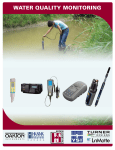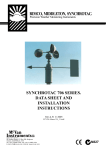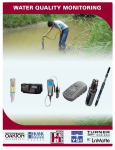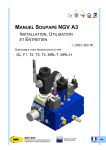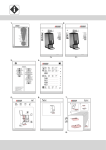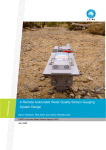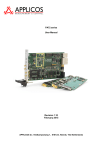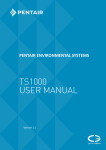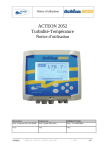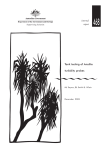Download Manual - RS Hydro
Transcript
NEP9504G Shown ANALITE NEP9000 AND NEP9500 SERIES TURBIDITY PROBE USER MANUAL V2.21 © 2007 ABN 56 007 28 96 58 Geddes Street, PO Box 298, Mulgrave Victoria, AUSTRALIA, 70 Tel: (+6-) 9582-7, Fax: (+6-) 9560-64 E-mail: [email protected], Internet: www.mcvan.com N827 Page V2.21 © 2007 V2.21 © 2007 Page ANALITE NEP9000 and NEP9500 Series Turbidity Probe User Manual Introduction Thank you for purchasing an ANALITE NEP9000 or NEP9500 series turbidity probe. It will give you years of service if you install and maintain it according to guidelines set out in this Manual. The ANALITE NEP9000 and NEP9500 series of turbidity probes are an enhanced version of our successful ANALITE 190 and 195 series probes. They offer better performance, more output options and greater ease of deployment yet are available in the same mechanical package (G version). The ANALITE NEP9000 and NEP9500 series turbidity probes are designed for monitoring and process applications where turbidity levels of up to 3,000NTU may be encountered. Standard ranges are 100NTU, 400NTU and 1,000NTU, but custom ranges are available. Specifically, the ANALITE NEP9000 probes are designed for applications that will not allow bio-fouling to build up such as short monitoring deployment or placement in fast and cold running water. The ANALITE NEP9500 probes however, with their integral wiper assembly, are designed where bio-fouling or sedimentation buildup is likely. The ANALITE NEP9000 and NEP9500 series of probes with a stainless steel case may be submerged to a depth of 100 meters (approx. 330 feet). The composite case version is rated to 30 meters (approx 100 feet). The ANALITE NEP9000 and NEP9500 probes use 90° optics and employs infrared light in accordance with ISO7027. All probes use a unique modulation technique that ensures almost total rejection of ambient light conditions as well as a unique microprocessor controlled differential sample and hold circuit for enhanced performance particularly at low turbidity levels. Applications The applications that the ANALITE NEP9000 and NEP9500 probes are so extensive and too numerous to elaborate on in this document but generally they include: 1) Monitoring of streams and rivers. 2) Monitoring of water storage bodies including stratification studies. 3) Intermediate and final effluent treatment monitoring. 4) Hydrological run off studies. 5) Ground and bore water analysis. 6) Drinking water filtration efficiency. 7) Industrial process monitoring. 8) Sludge and dredge monitoring. 9) Sediment load monitoring. Which model is best used is dependent on the application, the measuring environment, the logging equipment and the monitoring period (deployment times) required. The ANALITE turbidity probes are not suitable in situations where they may be abraded by large particles such as sand and under these circumstances the reading may become erratic due to the large particles passing the optic sensor. Measuring turbidity under these circumstances will require a stilling well to allow the sand particles to settle away from the optic sensor in the probe tip. Page V2.21 © 2007 Specifications Parameter Measurement NEP9001/9501 Technique ISO7027 - 90° Range 100NTU Output Span Response Time Linearity Zero Offset, 0 to 40°C Repeatability @ 25°C Temperature Coefficient (0 to 40°C) Calibration compliance using APS AEPA polymer solutions NEP9004/9504 NEP9010/9510 NEP90xx/95xx 400NTU 1,000NTU Custom to 3,000NTU max. ±2.5Volts or 4 – 20mA, where -2.5V or 4mA = 0NTU 0 to +1V and 0 to +2.5V outputs are also available. Specify output at time of order. Approx 1 second to 99%. 1% 1% 3% 5% ±3mV max. ±1% ±1% ±2% ±2% < ±0.05%/°C 4 points 0, 10, 40 and 100NTU 4 points 0, 40, 100 and 400NTU 4 points 0, 100, 400, and 1000NTU 3 points min. 0 and 2+ other values. Physical (Standard Version – see Physical Dimensions) Probe Diameter Probe only Length Overall Length Weight (probe only) Cable Connector Cable Length Environmental Static Depth Rating Operating Temp. Storage Temp. Wiper Wiper Arrangement NEP9500 series only Actuation NEP9500 series only Actuation Pulse Duration Actuation Pulse Current Sink Wiping Time Power Operating Voltage Current Consumption Power Settling Time Wiping Current Accessories NEP19WIPE NEP390-CA-xx NEP19SHRD NEP-CBL-xx Note: V2.21 © 2007 32mm for 316 stainless steel casing; 34mm for composite casing. 181mm without wiper, 188mm with wiper. 267mm without wiper; 274mm with wiper 120gms without wiper, 190gms with wiper. 5 core + shield. 6mm dia. PUR sheathed. 7 pin male waterproof to 100m when mated. Open face pressure of 50m Specify at time of order. Cable part number is NEP-CBL. 100m (stainless steel casing), 30m (composite casing) -5°C to +40°C -20°C to +50°C Disposable and consumable - Foam Pad on PVC or Acetal arm. Field replaceable. Mounted on central shaft, fixed by hex set screw onto flat of wiper shaft. 1. By external TTL/CMOS active low pulse or momentarily contacting the wiper actuation conductor (pin 5) to 0V (pin 3). 2. Automatic wipe every 2 hours if the wiper actuation conductor (pin 5) is permanently connected to 0V (pin 3) and also when applying normal power to the probe. On NEP9500 series only. >50mSec, <500mSec On NEP9500 series only. 1mA max. On NEP9500 series only. 8 second nominal. During the wipe the output is held to the output value just prior to the wipe ±1% . 9.6 - 28V dc 15mA maximum when not wiping plus up to 20mA if current output fitted. < 1 Sec NEP9500 series only. Additional 25mA approx at less than 30m submersion. Wiper Kit comprises 4 replacement wipers and hex fastening key for the ANALITE NEP9500 series only. Also used on the ANALITE NEP195, 395 & 495 probes. Shielded multi-core cable assembly including mating connector to suit the standard version. Length xx to be specified at time of probe order. Stainless protective shroud to suit the NEP9000 and NEP9500 series. Cable only xx meters - specify at time of order. Required for G version. The standard version utilises the water proof connector. The version utilising a fixed and glanded cable includes the “G” suffix after the part number (eg NEP9504G). Page Installation There are two aspects to consider when preparing to install the ANALITE NEP9000 or NEP9500 series probes in the field. 1) Installation of the probe proper into the environment where measurements are to take place. 2) Cabling considerations. 3) Connection of the probe into the data collection and control system. Probe Installation The probe is normally installed with the optics pointing downwards (but not vertical) or in a horizontal alignment. In a simple application the probe is simply immersed into the water to the desired depth, but within the depth rating of the probe. Please note the depth rating is based on static water. Allowances must be made for the effect of flowing water to ensure the static depth rating is not exceeded. If the probe is to be installed downwards then it is recommended to install it a few degrees away from the vertical to allow bubbles to escape away from the optic face. Probes with integrated wiping should be installed such that they can be easily retreived from time to time to replace the wiper arm assembly. It is important that the optic end of the probe is kept clear of obstruction such as the river bed. The minimum distance between the optic head and any object should be 50mm (2”). The standard casing of the ANALITE NEP9000 and NEP9500 series probes are made of 316 stainless steel but the optic face is made of plastic materials and so should be protected from accidental scratching or abrasion. The wiper arm assembly should be replaced periodically to avoid abrasive material build-up in the pad that may eventually abrade the optic face. The optic face is partially protected from damage by the protruding castellations in the probe casing. To avoid crevice corrosion on the 316 stainless steel casing in salt and acidic water deployments it is strongly recommended that the probe be thoroughly washed in clean water after deployment and prior to storage. Failure due to crevice corrosion is not covered under warranty. A composite cased version is available for corrosive and sea water environments but its pressure rating is limited 30m. If the probe body is to be installed in a glanded fitting (for insertion into a pipe etc.) then care must be taken to ensure the sealing surface pressures offered by the gland fitting are not excessive so as to not cause distortion of the probe casing and force leakage. The ANALITE NEP9000 and NEP9500 series probes are thin wall instrument and so glanding pressure must be minimal and spread over the largest possible area. Do not cut or damage the outer sheath of the cable. Water may enter the probe through holes or cuts in the cable sheath. Where damage may occur due to river rocks striking or rolling over the probe body, a protective shroud should be used which can be made of simple PVC piping or stainless steel which ever the situation warrants. A shroud is available for the NEP9000 and NEP9500 as an accessory under the part number NEP19SHRD. Such a shroud not only protects the probe but also assist in maintaining a minimum distance between probe optics and any local obstructions. Cabling Considerations Physical Cable normally supplied with the ANALITE NEP9000 and NEP9500 series probes is a specially selected PUR sheathed and screened cable selected for strength, chemical resilience and exceptional resistance to cuts, nicks and abrasion. The cable part number is NEP-CBL. Never the less, care should be taken during the installation process of the probe and its cabling to ensure that the cable is not subjected to persistent pulling, snagging, abrasion or severe compression. This is particularly important for the probes with fixed and glanded cable as any water penetration through the cable sheath may find its way into the probe proper affecting the accuracy of the readings and possibly causing irreparable damage. For probes fitted with connectors care must be taken to ensure the connectors are properly mated to ensure a seal yet not screwed together too tightly so as to make their disconnection difficult after a long deployment. Prior to mating make sure both the probe and cable connectors are dry in the termination area otherwise erratic operation may occur due to moisture. Page V2.21 © 2007 Electrical Because long cable lengths are common some electrical factors should be taken into account and these are discussed below. Voltage Output Version ANALITE NEP9000 and NEP9500 probes may have an analogue voltage output with a nominal output impedance of 100 ohms. Conductor resistance is nominally 73 ohms/km or 7.3 ohms for 100 meter probe cable and this may need to be taken into account in some configurations particularly with regards to logger channels that have low input impedance (say less than 10,000 ohms). For particularly long cable runs, the 4 – 20mA current output version is recommended. 4 – 20mA Current Output Version ANALITE NEP9000 and NEP9500 probes may have an analogue 4 – 20mA current output with a maximum load rating of 350ohms, consequently cable loop resistance should be taken into account. The PUR cable normally supplied with the probes has a nominal loop resistance of 14.6 ohms per 100m. A schematic of the probe and its load is shown below. For very long cable runs (>200m), it may be advisable to connect the the NTU Return conductor to the Supply Common conductor at the end of the cable to reduce the voltage drop along the run. Surge and Lightning Considerations Surge and lightning protection may also have to be considered given that many installations are “in the wild”. It is important to note that the NEP9000 and NEP9500 series probes have the stainless steel casing terminated only to the cable shield. There is no electrical contact between the casing and the probe electronics. The signal ground (4) and power ground (3) are electrically bound together within the probe. Probe Connection The standard version of the NEP9000 and NEP9500 probes are fitted with a 7 pin male marine connector with an open face pressure rating of 50m. This means that if the probe is accidentally submerged when not connected, or improperly connected to its mating cable assembly, a pressure rating of only 50m is offered. The mating female cable connector is supplied with the specifiied cable length. When the cable connector is properly mated to the probe the overall pressure rating is 100m. A fixed and glanded cable version is also available and these versions have the G suffix attached to the part number. The cable conductor assignment is as shown below: Note that the Signal Common (yellow) and Supply Common (green) conductors are electrically connected together within the probe. The stainless steel cover is connected only to the cable shield. The probe is designed to operate with most data loggers, PLC and DAS systems available today. When using the NEP9500 models some form of wiper actuation control may be required depending on the wiping protocol selected. This is discuss later in this manual. V2.21 © 2007 Page Pin 2 - BROWN Pin - GREEN Pin 5 - GREY NEP90xx PROBE OR NEP95xx PROBE SHIELD Pin - WHITE NO WIPE FUNCTION ON NEP90xx PROBES Pin 4 - YELLOW 9.6 - 28VDC SUPPLY +VE 0V SUPPLY COMMON PROBE RESET- NEP9000 PROBE RESET/WIPE/AUTO WIPE - NEP9500 ONLY NO CONNECTION WITHIN PROBE NTU OUTPUT (V or I+) NTU COMMON (V) or RETURN (I-) There are two wiping protocols available on the NEP9500 probes: 1. A single wipe externally initiated by momentarily reseting the probe. 2. An automatic wipe every two hours by terminating the Reset/Wipe to the Power Common.. 1. The wiper on the NEP9500 probes can be actuated by momentarily connecting the Reset/Wipe conductor (5) to the Power Common conductor (3) for longer than 50msec but less than 0.5 second. This has the effect of resetting the probe which then initiates a wipe immediately after the inbuilt microprocessor has properly reset.This protocol can be implemented using a mechanical switch arrangement or open collector (drain) output available on most loggers. For multiple wipes each consecutive wipe must be actuated after the wiper has parked in its rest position (approx. 8 seconds after a wipe actuation). Reset/Wipe pulses applied during a wipe action will be ignored. Note that during the wipe period the NTU output will be held at the value measured just prior to the wipe (within 1%). The recommended external wiper activation interface arrangements are shown schematically below. 2. Permenately connecting the Reset/Wipe conductor (5) to the Power Common (3) will force an automatic wipe every two hours and when the probe power is applied. Note that during the wipe period the NTU output will be held at the value measured just prior to the wipe (within 1%). Output from the probe during the initial wipe on a power up should be disregarded and data treated as valid, say, about 12 seconds after the power is applied. The termination arrangement for the 2 hourly auto-wipe is shown schematically below. +5V 4k7 To Wiper Actuation Circuitry 470 Auto-wipe every 2 hours Grey Single wipe activation by external means 5 N.O. R >50mS, <500mS 0V Green NEP9500 SERIES PROBE Switch Actuation Typical Semiconductor Actuation Current Output Arrangement When a NEP9000 or NEP9500 series probe is ordered with the 4 – 20mA current output, the probe is configured as a (high) current source. The load must be less than 350 ohms to ensure proper operation over the probe’s specified power supply range. The connection arrangment for a probe with a current output is shown below. Page V2.21 © 2007 Pin 2 - BROWN 9.6 - 28VDC SUPPLY +VE Pin - GREEN 0V SUPPLY COMMON Pin 5 - GREY NEP90xx PROBE OR NEP95xx PROBE PROBE RESET- NEP9000 PROBE RESET/WIPE/AUTO WIPE - NEP9500 ONLY SHIELD NO CONNECTION WITHIN PROBE Pin - WHITE NO WIPE FUNCTION ON NEP90xx PROBES + Note: Pins and 4 are connected together within the probe. CURRENT OUT (4-20mA) 4-20mA Monitor/Display 50 ohm impedance maximum Pin 4 - YELLOW - CURRENT RETURN Connection to the ANALITE TM5 The NEP9000 and NEP9500 series are readiliy interfacable to the ANALITE TM5 Indicator/Controller unit the probe output must be either ±2.5V or 4-20mA. The ANALITE TM5 is ideal for industrial control and alarm applications. The ANALITE TM5 allows for the selection of wiping intervals as well as allowing field calibration. More information on the ANALITE TM5 can be downloaded from the McVan Instruments website at www.mcvan.com. Normal termination of a NEP9000 or NEP9500 series probe with ±2.5V output to an ANALITE TM5 is as tabled below: ANALITE NEP9xxx Probe Pin 1 2 3 4 5 ANALITE TM5 Colour White Brown Green Yellow Grey Term No. 46 44 43 45 47 Circuit NTU Vout Signal +12Vdc Power Power Common NTU Vout Common Clean (Wipe) – NEP95xx only If the TM5 is fitted with the 4-20mA input option, a NEP9000 or NEP9500 series probe with current output may be terminated as tabled below: ANALITE NEP9xxx Probe Pin 1 2 3 4 5 V2.21 © 2007 ANALITE TM5 with 4-20mA option Colour White Brown Green Yellow Grey Term No. 50 44 43 51 47 Page Circuit NTU I+ Signal +12Vdc Power Power Common NTU I- Signal Clean (Wipe) – NEP95xx only Wiper Replacement This applies to the NEP9500 versions only. The effectiveness of the wiper in maintaining a clean optical surface will eventually be compromised, the time being dependent on the water under investigation and the number of wiping cycles carried out. We recommend periodic inspection of the wiper pad to determine if the material is deteriorating or is impregnated with material from bio-fouling. Normally the wiper should be replaced every 4 to 6 weeks of deployment. In addition, as a precaution we recommend changing the wiper prior to each deployment. The wiper is a consumable item and a spare is provided with each NEP9500 series probe along with a hex key to loosen and fasten the wiper set screw. Wiper packs containing four wipers and a hex key are available (Part Number NEP19WIPE) as a standard accessory. To change the wiper, loosen the set screw in the wiper arm until the wiper assembly can be removed from the wiping shaft. Place a new wiper assembly on the shaft with the set screw aligned squarely with the flat on the wiping shaft. Gently press the wiper arm down until the wiper arm hits the stop on the shaft. The wiper pad should now be compressed to roughly one half its original thickness. Tighten the set screw - do not over tighten. It is important that the wiper arm does not make contact with the probe face - only the pad should be in contact. A gap of 0.5mm between the wiper arm and the optic face is typical when a new pad has been properly installed. NOTE: It is imperrative that the set screw be fastened squarely aligned onto the flat on the shaft otherwise proper operation will be affected. CAUTION: Do not over tighten the set screw or manually attempt to rotate the wiper arm once set onto the shaft. Any attempt to manually rotate the wiper may cause gearbox damage and void the warranty. Calibration Confirmation and Turbidity Standards The ANALITE NEP9000 and NEP9500 probes are factory calibrated using non-toxic neutral-density polymer-based turbidity standards. Solution values up to 1,000NTU as USA EPA certified. 10NTU, 40NTU, 100NTU, 400NTU and 1,000NTU neutral-density polymer-based turbidity standards are available from McVan Instruments and their distributors, or directly from the manufacturer for US customers only. We recommend the use of one of these standards and pure water for a calibration confirmation. The standards should not be diluted, as this will reduce the effect of the anti-fungal agent contained in the standard solutions. Because a turbidity probe is inherently an optical device, care must be taken during a calibration confirmation to ensure that external optical effects are kept to a minimum. This is best implemented by placing calibration solutions in dark, leak proof bottles with a non-reflective finish such as Nalgene® 2106 bottles in amber. These are available from McVan Instruments with wide necks and a nominal capacity of 1,000ml and carry the part number NEP-BTL. The calibration routine is best done under natural or incandescent lighting (not fluorescent or arc). Another critical factor is cleanliness. Any debris or water that makes its way into the calibration solutions will affect its value. It is therefore a good practice to have an ample supply of distilled de-ionized water and a means of properly drying the probe end (clean compressed air is ideal). Wipers should always be removed prior to a calibration routine. Probes should be flushed in two containers of distilled water with thorough drying in between and before insertion into a calibration solution. Also where ever possible, a calibration confirmation should commence at a lower value (usually zero) and work up in value to further minimize the effects of cross contamination. CAUTION: ALWAYS REMOVE THE WIPER PRIOR TO CALIBRATION. When inserting the NEP9000 or NEP9500 probe into a calibration solution ensure that the optic face of the probe is at least 50mm from the base and all sides of the bottle. This is particularly important for low turbidity solutions below 200NTU. Hold the probe a few degrees from the vertical and gently tap it on the bottle rim so as to dislodge any air bubble on the optic face. If the probe is properly placed the measurement value will not vary if the probe is gently moved a few millimeters in any direction. Page V2.21 © 2007 Physical Dimensions NEP9000 and NEP9500 Probes Warranty The ANALITE NEP9000 and NEP9500 series turbidity probes are warranted against defects in material and workmanship for one year from date of purchase, exclusive of the wiper assembly. The warranty does not cover the wiper arm assembly, corrosion or leakage due to corrosion. Unauthorized service, tampering or abuse will void this warranty. Damage as a result of improper installation will also void this warranty. Should you require service (under warranty or otherwise) please contact the McVan Instrument distributor from whom you purchased the probe, or our Service Centre. If the probe is being returned for service under warranty please supply proof of purchase. All support enquiries must include the serial number of the probe – labelled on the casing of the probe. The shipping address for probe returns is: McVan Instruments’ Service Centre 58 Geddes Street, Mulgrave VIC 3170 AUSTRALIA. Tel: (+61-3) 9582-7333, Fax: (+61-3) 9560-1164 E-mail: [email protected] V2.21 © 2007 Page 10 Electrical Conformity EC Declaration of Conformity according to Council Directive 89/336/EEC We, McVan Instruments Pty Ltd, declare under our sole responsibility that the product: Analite NEP9000 and NEP9500 SERIES of turbidity probes and accessories, Manufactured by: McVan Instruments Pty Ltd To which this declaration relates, are in conformity with the protection requirements of Council Directives 89/336/ EEC on the approximation of the laws relating to electromagnetic compatibly. This Declaration of Conformity is based upon compliance of the product with the following harmonised standards: Emissions: Immunity: EN50081-1:1992 EN50082-1:1997 Signed by: John Van de Vreede – Director Date of Issue:1 DECEMBER 2002 Place of Issue: McVan Instruments Pty Ltd 58 Geddes Street, Mulgrave VIC 3170 Australia N827 ABN 56 007 28 96 58 Geddes Street, PO Box 298, Mulgrave Victoria, AUSTRALIA, 70 Tel: (+6-) 9582-7, Fax: (+6-) 9560-64 E-mail: [email protected], Internet: www.mcvan.com Page 11 V2.21 © 2007 Protection Shroud 90 mm for NEP260 probe 20mm for NEP9xxx probes 9 mm 40 mm 5 mm INSERT PROBE OD8.2mm off M4 x 8 hex SS set-screws @ 20° to fasten to probe end. Flow through holes (approx .5 dia) FITTING Insert the Analite turbidity probe into the shroud as shown. Ensure end of probe is against internal stop at other end of shroud. Rotate the probe in the shroud so as to give the lowest possible (NTU) output when in clear water. Fasten the M4 screws onto the probe end. (Do not over tighten). Re-zero the instrument with the shroud fitted. Approximate weight of the shroud alone is 400grams Material: 6 Stainless Steel © 999 - 2005 McVan Instruments Pty Ltd File: NEP SHROUD for NEP60 and NEP9xxx.cdr Product Identification Nomenclature POLARITY Omit = ±2.5v U = Unipolar +1v or +2.5V Omit = Current output NEP9 OUTPUT V = Voltage I = Current CASING Omit = Stainless steel P = Composite X Examples: WIPING 0 = Non-wiping 5 = Wiping RANGE 01 = 100NTU 04 = 400NTU 10 = 1,000NTU 30 = 3,000NTU UNIPOLAR A = 0 - 1v B = 0 - 2.5v Omit = ±2.5v Omit = Current output CONNECTOR Omit = Connector G = Fixed glanded cable. Omit means that character is completely left out of the product code if the indicated parameter is required (see examples). IS. C/N NEP9010UBXVP Probe without wiping, 1000NTU range with standard connector and unipolar 0 - 2.5v voltage output. Casing is composite. NEP9501GXI Probe with wiping, 100NTU range with glanded cable fitted and 4-20mA current output. Casing is stainless steel. © DATE Tolerances: Lin ±0.2mm, Ang ±0.5°. Unless otherwise stated. ABN 56 007 28 96 58 Geddes Street, PO Box 298, Mulgrave Victoria, AUSTRALIA, 70 Tel: (+6-) 9582-7, Fax: (+6-) 9560-64 E-mail: [email protected], Internet: www.mcvan.com V2.21 © 2007 NEP9504GXV Probe with wiping, 400NTU range with glanded cable fitted and ±2.5v voltage output. Casing is stainless steel. Page 12 2005 Copyright Status P NEP9xxx PRODUCT IDENTIFICATION NOMENCLATURE 25/2/05 DRN KH SHEET SCALE DWG No. ISS TBA NTS 1 OF 1 B APP JVdV 25/2/05 File: NEP9xxxX Conductor Assignment.cdr, 2/05












